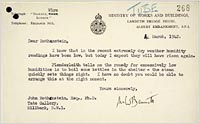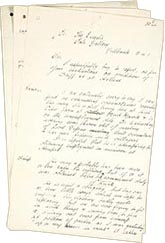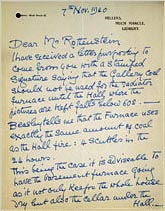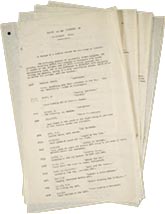|
Storage

Although the evacuation itself went smoothly, the ongoing storage of work was not without its hitches.
Problems arose relating to the evacuation and accommodation of those Tate staff assigned to mind the works of art.
Evacuation allowances were not always sufficient (many of the men were still paying rent in London as well as accommodation costs in their temporary homes)
and living conditions were basic, some even had to share beds.
The Archive has several letters from attendants to the Director and other senior staff asking for provision of basic essentials such as furniture and bedding.
Senior Warder William Chappin in his report on staff at Hellens noted that one of the attendant's 'clothing badly needs replacing'.
Away from their homes and families, they often became bored.
Chappin tells of the attendants 'Leaving at will and going to the local Public House while on duty'.
He also reports on one attendant brawling with the local villagers.
A further concern was friction between staff assigned to mind the works of art and the aristocratic owners of the country houses.
Tate employees complained of being treated like servants and being asked to do extra jobs on the country estates.
| Lady Helena Gleichen asked me to go out and help with the hay making and, when I refused, loudly abused me in front of her three young maids... |

Letter from Attendant E Higginson to the Director(?), 28 June 1940
|
| Her ladyship was under the impression that I could give the men an order to do certain jobs of work outside their scope of duty
I informed her that this could not be so, but I informed her that what the men done for her was only in a voluntary capacity |

Letter from Senoir Attendant Sgt R Beasley to the Director(?), 23 June 1940 |
There were also practical problems relating to storage.
A constant temperature (60 degrees Fahrenheit) had to be maintained, and owners became worried about the cost of heating their homes to the necessary level.
| It was so cold last winter that it was with the greatest difficulty that we kept the hall, where the pictures are, up to the required
temperature of 60 degrees. |

Letter from Lady Helena Gleichen to Robin Ironside, 15 Nov 1940 |
It was decided that as well as space and heating, exit routes in the event of fire at Hellens and Eastington were inadequate, and in July 1941, works were removed to Sudely Castle and Old Quarries in Gloucestershire, and subsequently in June 1942, to Abbotswood, Gloucestershire.
Lady Helena Gleichen was very happy to be relieved of her duty and have her house back to normal:
| Dear Mr Rothenstein - I was delighted to get your letter yesterday as our guests, although inanimate have spoilt the look of our hall
- I will not deny. |

Letter from Lady Helena Gleichen to John Rothenstein, 7 May 1941 |
 |
The storage of work in the underground also had its problems.
With humidity levels lower than those recommended for storing art works, The Ministry of Works and Buildings suggested a rather unusual solution
to the problem, as this letter (left) shows.

 Correspondance concerning humidity levels in the underground.
Correspondance concerning humidity levels in the underground.
© Crown copyright material is reproduced with the permision of the Controller of HMSO and Queens Printer for Scotland |
|

Report by Sgt Warder Chappin
concerning staff at 'Hellens'
© Tate Archive 2003

Letter from Helena Gleichen
to John Rothenstein
Copyright holder untraced

Report on pictures held at
Eastington, Hellens and Muncaster
© Tate Archive 2003 |
